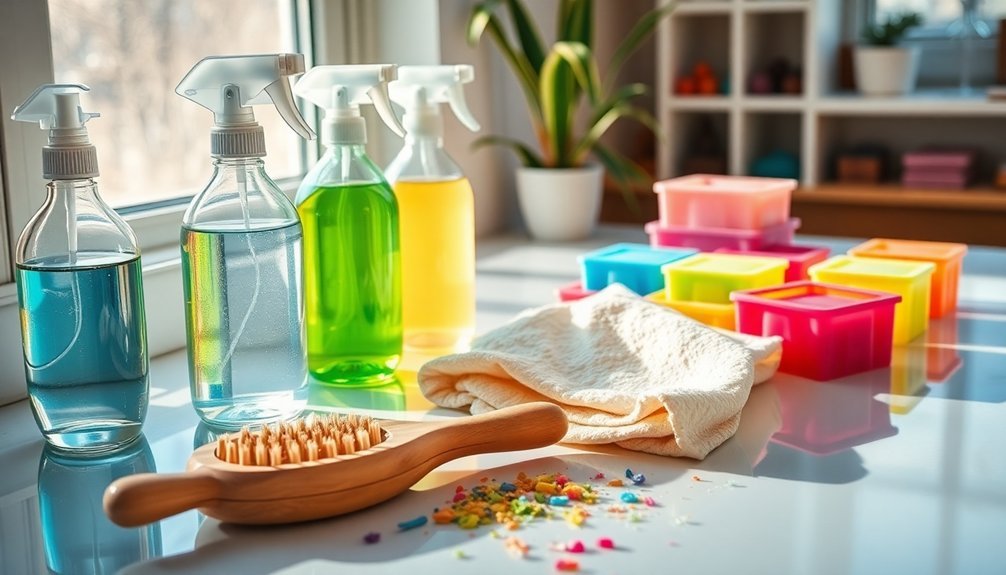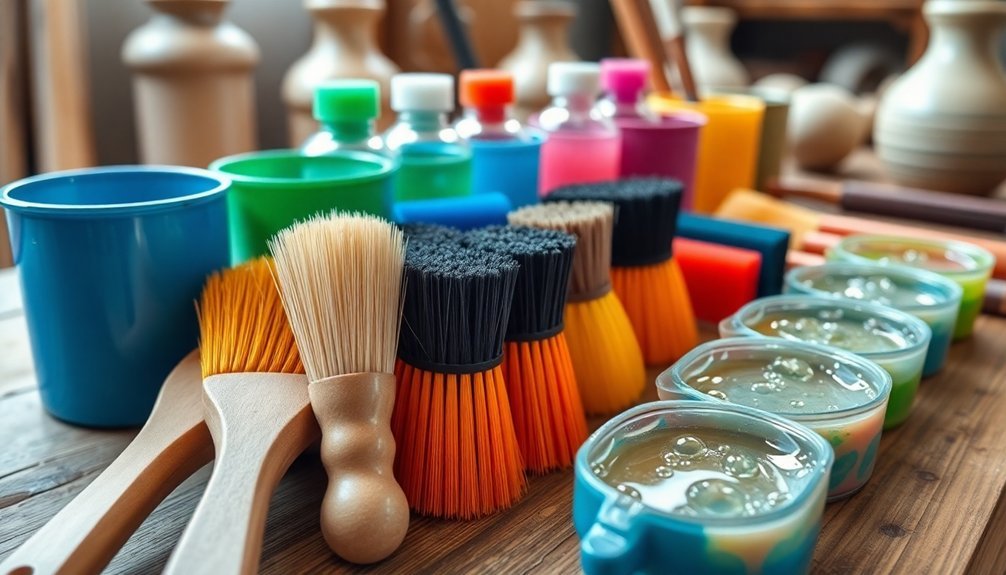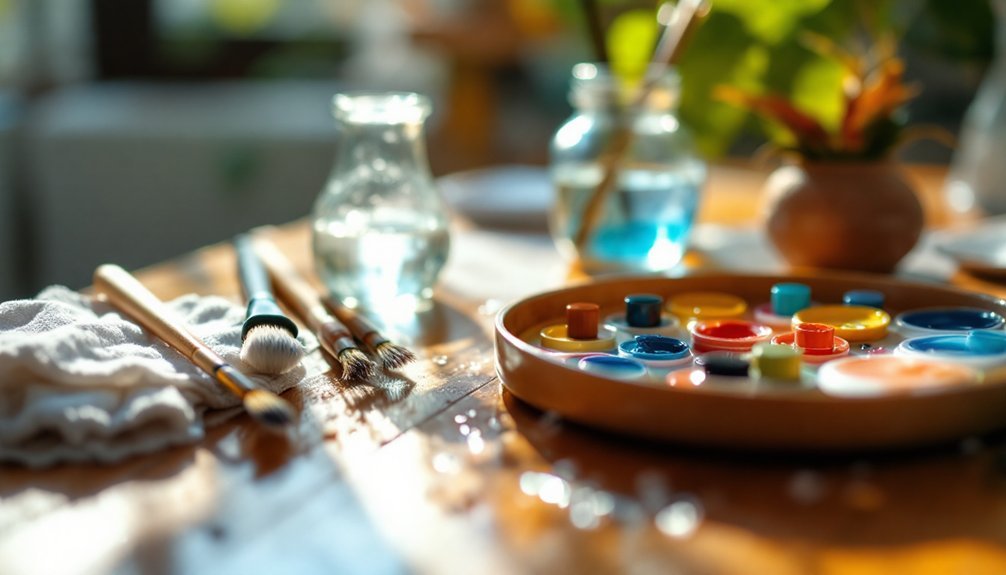Keeping your crafting equipment clean doesn't have to be difficult. First, try hot water soaking—simply submerge tools for 15 minutes to dissolve residues naturally. Second, use eco-friendly cleansers like baking soda and vinegar to tackle stubborn buildup without harsh chemicals. Third, invest in dedicated brushes designed for your specific tools to make cleaning more efficient. These simple techniques will extend your equipment's lifespan and improve your craft results considerably.
Eco-Friendly Cleansers for Soap Residue Removal

When cleaning your soap-making tools and equipment, eco-friendly cleansers offer effective solutions without harsh chemicals. Baking soda works as a mild abrasive that easily scrubs away soap residue from your tools, while vinegar's acidic properties help dissolve stubborn buildup.
Protect your soap-making equipment and the planet by choosing eco-friendly cleansers like baking soda and vinegar.
For a powerful cleaning combination, create a fizzing reaction by mixing baking soda and vinegar directly on your equipment. This natural chemical reaction loosens soap scum effectively.
For disinfecting properties, add citric acid or lemon juice to your cleaning solutions. Dr. Bronner's Castile soap diluted with water makes an excellent cleaner for your soap-making equipment.
You'll also find commercial options like Scum Bum and Puracy that maintain eco-friendly standards while providing powerful cleaning. These approaches protect both your equipment and the environment while ensuring your crafting tools stay pristine.
Hot Water Soaking Techniques for Soap Making Tools
The simplest yet most effective method for cleaning soap making equipment begins with hot water soaking.
Submerge your tools in extremely hot water to soften and dissolve soap residue. For most items, 15 minutes is sufficient, though stubborn residue might require several days.
For stick blenders, submerge the head and turn it on briefly to clean internal parts.
Fill containers and bowls with hot water to tackle residue inside. When cleaning utensils and spatulas, a quick soak prevents buildup.
Always wear gloves to protect your skin, and add grease-cutting dish soap for enhanced cleaning power.
Remember that tools used with oils and fragrances typically need longer soaking times.
This method not only effectively breaks down soap residue but also reduces your need for harsh chemical cleaners. Wiping equipment with paper towels first helps remove excess residue before the soaking process begins.
Dedicated Brushes and Scrubbers for Vessel Maintenance

Beyond hot water soaking, effective soap making equipment maintenance requires proper brushes and scrubbers dedicated to the task.
You'll find rotating brushes considerably reduce cleaning time while providing more thorough results than manual scrubbing alone.
Select brushes based on your specific equipment and residue type. For dried soap residue, opt for special-grade materials that penetrate without damaging vessel surfaces. Non-metallic brushes work best for delicate materials like glass or certain plastics, while metal bristles effectively tackle tougher buildup on steel vessels.
These specialized tools not only improve cleaning efficiency but also reduce your exposure to cleaning solvents.
Regular inspection of your brushes guarantees peak performance—replace them when you notice signs of wear to maintain effective cleaning power for all your soap making equipment.
Frequently Asked Questions
How Do I Remove Hardened Clay From Carving Tools?
To remove hardened clay from carving tools, heat them in a low-temperature oven (170°F) for 30 minutes, then wipe off the softened clay. You can also soak tools in rubbing alcohol and scrub with a toothbrush.
Can I Use Dishwashers for Cleaning Plastic Craft Stencils?
No, you shouldn't use dishwashers for plastic stencils. The high heat can warp them, and harsh detergents damage design integrity. Instead, use warm soapy water, a soft brush, or baby wipes for gentle cleaning.
What's the Best Way to Clean Glitter off Workspace Surfaces?
Use a lint roller or sticky tape to lift glitter from your workspace surfaces. For stubborn bits, try a damp sponge or Play-Doh. Microfiber cloths work well after applying a water-vinegar solution.
How Often Should I Replace My Craft Cutting Mats?
Replace cutting mats when you notice deep gouges, uneven cuts, or fabric snagging. Typically, with proper care, they'll last 1-3 years depending on usage frequency, blade sharpness, and mat thickness. Rotate regularly to extend lifespan.
Can Vinegar Damage Metal Crafting Tools if Used Regularly?
Yes, regular vinegar use can damage your metal crafting tools. It corrodes aluminum and steel, and etches copper. You'll want to limit exposure time, rinse thoroughly, and consider milder alternatives like dish soap instead.
In Summary
You'll find that maintaining your soap crafting equipment doesn't have to be complicated. By using eco-friendly cleansers to tackle stubborn soap residue, implementing proper hot water soaking techniques, and investing in dedicated brushes and scrubbers for your vessels, you're ensuring the longevity of your tools. These simple cleaning methods will keep your equipment in top condition, allowing you to focus on what matters most—your creative soap making process.





Leave a Reply